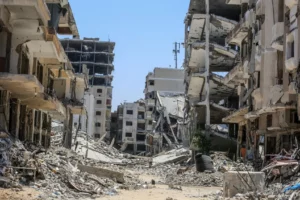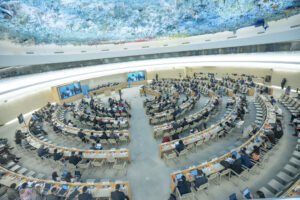II. QUESTIONNAIRE
Questions on women human rights defenders and those working on women’s rights and gender issues: risks, security and protection. It would be deeply appreciated if responses were brief. They may be submitted in bullet- points if preferred. For non-Governmental organizations (NGOs), should they so wish, their identity will remain confidential (only the country where they operate will be disclosed). Furthermore, they shall only answer questions, which are relevant to them, and may share information about defenders other than themselves.
1.Please indicate, with brief examples, the main challenges and risks that women defenders and those working on women’s rights and gender issues face in your country. Please refer to the specific security needs of women defenders and those working on women’s rights and gender issues in your country.
2. Please list specific legislative measures (excluding Constitutional provisions) and/or concrete short and long-term protection strategies/programmes (including early warning mechanisms and the work of existing national human rights institutions) which have been, or are to be, adopted and/or implemented to specifically address the safety and protection of women defenders and those working on women’s rights and gender issues in your country. How have the specific needs of women defenders and those working on women’s rights and gender issues been taken into account in the designing and implementation of these measures, strategies and programmes?
3. In the absence of effective protection, please provide concrete examples on how women defenders and those working on women’s rights and gender issues strive to keep themselves safe, either individually or collectively, at the local level in your country.
4.Please list specific protection programmes and/or tools for women defenders and those working on women’s rights and gender issues developed by non-Governmental organizations at the national, regional and international levels. In your view, what are their main strengths and challenges?
5.Please describe specific measures adopted by the relevant regional human rights mechanisms1 to address the specific protection needs of women defenders and those working on women’s rights and gender issues who are at risk.
III. RESPONSES RECEIVED TO THE QUESTIONNAIRE
Argentina
Question 3: Response from the Government
18. Además de lo mencionado en los párrafos precedentes, las redes de mujeres, de profesionales y de personas sensibles a los derechos humanos de las mujeres, las niñas y niños y los grupos de homosexuales, bisexuales, lesbianas y personas transgénero, constituyen un sistema de alerta contra estas presionas y amenazas, mediante su difusión pública, sanción social y demanda de investigación.
Mesoamerica
Question 4: response from Just Associates (JASS)
826. Impulsar campañas y materiales que desmonten los mitos y prejuicios alrededor del trabajo y valor de las defensoras. Sobre todo el movimiento feminista y lésbico han trabajado mucho en la sensibilización y comprensión de la sociedad, sobre la importancia de los derechos de las mujeres, de las diversidades sexuales; a través de campañas y materiales educativos. También el movimiento trans y de trabajadoras sexuales ha contribuido a combatir los estereotipos y estigmas que están detrás de muchas agresiones a las defensoras.
827. Fondos flexibles de emergencia. Dentro de la filantropía feminista y los fondos de mujeres se ha venido reflexionando sobre la necesidad de recursos para las defensoras que necesiten protección. En algunos casos se han etiquetado algunos fondos específicos para esto. Sin embargo los recursos asignados son insuficientes, muchas veces no pueden ser asignados oportunamente por los procedimientos administrativos y no todos los fondos de mujeres cuentan con este tipo de apoyo.
El Salvador
Question 1: response from the Government
183. Es importante señalar que otro aspecto que afecta la labor de defensa es que existen sectores radicales dentro de la sociedad, que por el abordaje de ciertos temas o grupos (ejemplo: las personas privadas de libertad, la comunidad gay, lesbianas, transexuales, entre otros), atacan incluso por medios de comunicación a los y las defensoras, tildándolos de defensores de delincuentes.
184. Recientemente, luego de la aprobación de la Ley Especial Integral para una vida libre de violencia para las Mujeres, se han dado una serie de comentarios y señalamientos peyorativos por parte de los medios de comunicación a las y los defensores de los derechos humanos, en este caso en particular a la Directora Ejecutiva del Instituto Salvadoreño para el Desarrollo de la Mujer (ISDEMU), licenciada Julia Evelyn Martínez y a la Procuradora adjunta de la Familia y la Mujer, de la Procuraduría para la Defensa de los Derechos Humanos (PDDH), licenciada Raquel Caballero de Guevara. En esta ocasión, a través de medios de comunicación escrita, fueron tildadas de lesbianas, frente a lo cual han tenido que aclarar la situación y enfrentar este tipo de difamación por haberse pronunciado a favor de esta ley, que amplía el marco jurídico para erradicar la violencia contra la mujer. Ejemplo de ello es la Carta a los diputados de la Asamblea Legislativa, de Paolo Lüers, publicada el sábado, 27 de noviembre de 2010.
Canada
Question 2: response from the Government
80. In Canada, human rights defenders are well protected, as are all individuals in Canada, through a combination of constitutional and legislative measures.
81. The Canadian Charter of Rights and Freedoms guarantees all individuals in Canada freedom of conscience and religion; freedom of thought, belief, opinion and expression, including freedom of the press; freedom of peaceful assembly; and freedom of association.
82. Section 15 of the Canadian Charter of Rights and Freedoms, ensures equal protection and equal benefit of the law “without discrimination based on race, national or ethnic origin, colour, religion, sex, age or mental or physical disability”. This list of prohibited grounds is not closed. Courts have expanded it to include grounds such as sexual orientation and marital status. Section 15 protects against both direct discrimination and adverse effect discrimination which means that even if the purpose or intent is not discriminatory, a measure may be discriminatory if the effect is to deny an individual equal protection or benefit of the law.
Ireland
Question 3: Response from the Government
378. The Guidelines for applications to Irish Aid’s Civil Society Fund in 2010 indicated that priority consideration would be given to interventions that contribute to specific policy objectives of the Irish Government, including interventions in the area of the protection of human rights defenders, the prevention of gender-based violence, and interventions that strengthen the participation and representation of poor and marginalized people in the international human rights system. Ireland recognizes that certain human rights defenders face particular risks, including women human rights defenders and those defenders working on issues relating to discrimination on the basis of sexual orientation.
Serbia
Question 1: response from the Government
701. The main challenges and risks faced by women human rights defenders and other persons dealing with women’s rights and gender equality are associated with a misunderstanding on the part of patriarchal mentality and conservative and traditionalist circles existing in Serbia. This refers above all to the challenges and risks that are faced by persons whose work focuses on the rights of sexual minorities.
Link to full text of the report: http://www2.ohchr.org/english/bodies/hrcouncil/docs/16session/A-HRC-16-44-Add3_AEFS.pdf




